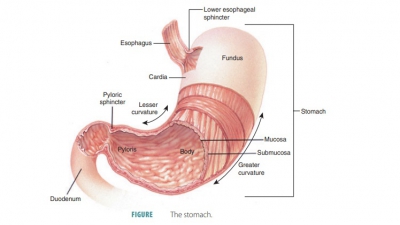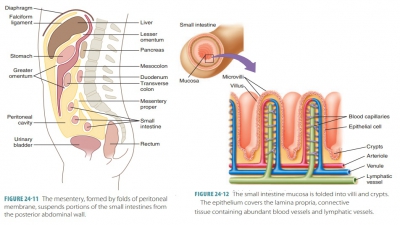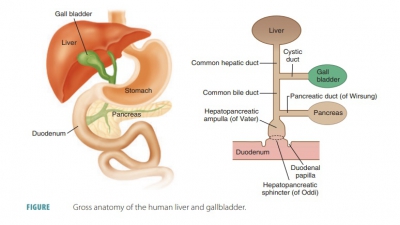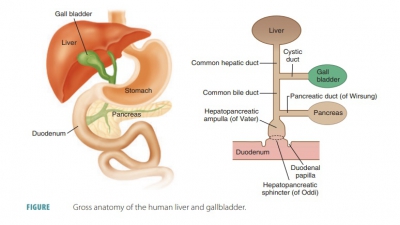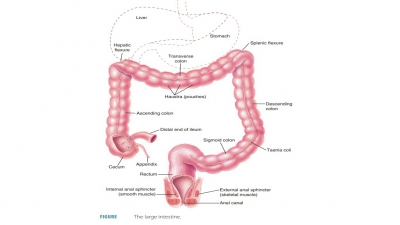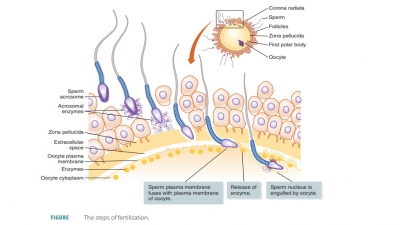Pancreas
| Home | | Anatomy and Physiology | | Anatomy and Physiology Health Education (APHE) |Chapter: Anatomy and Physiology for Health Professionals: Digestive System
The pancreas lies posterior to the stomach, extend-ing laterally from the duodenum toward the spleen.
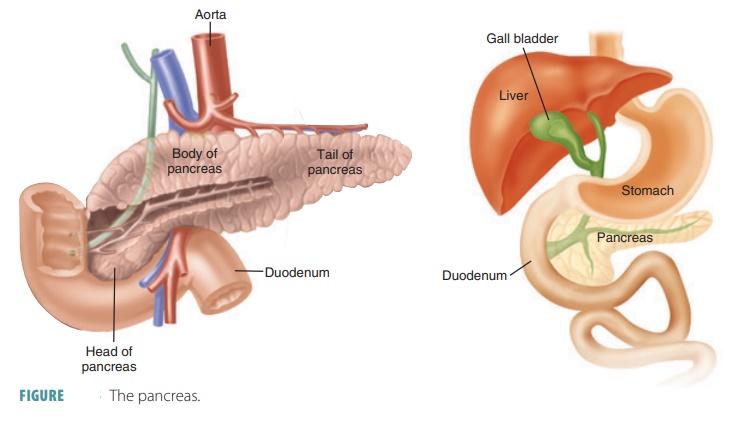
Pancreas
The pancreas lies
posterior to the stomach, extend-ing laterally from the duodenum toward the
spleen. It is an elongated, tadpole-shaped organ, about 15 cm in length and
weighing about 80 g or 3 ounces. The broad head
of the pancreas lies within the loop that is formed by the duodenum of the
intestine. The thin-ner body of the
pancreas extends toward the spleen, whereas the tail appears short and bluntly rounded and abuts the spleen (FIGURE 24-15).
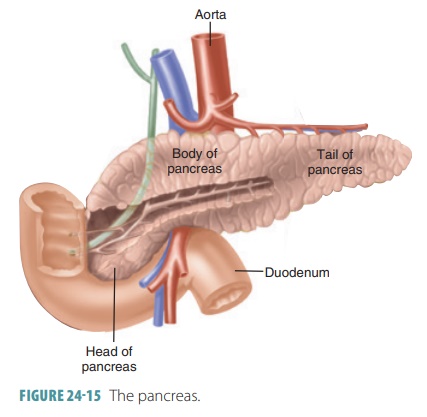
The pancreas is retroperitoneal,
firmly bound to the posterior abdominal cavity wall. It not only acts as an
endocrine gland, but also has an exocrine function— it secretes the digestive
juice known as pancreatic juice. Pancreatic acinar cells produce pancreatic
juice and
make up most of the pancreas. Smaller pancreatic tubes form larger ones, and
eventually the main
pan-creatic duct, connected with the duodenum at the same place where the bile duct, from the liver
and gallbladder, joins the duodenum (Figure 24-14). A smaller accessory pancreatic duct
empties into the duodenum, proximal to the main pancreatic duct. The movement
of pancreatic juices is controlled by a hepa-topancreatic sphincter.
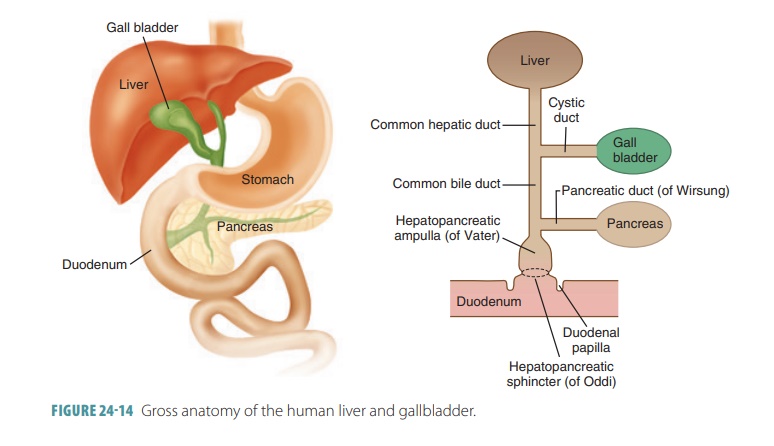
The secretions of the pancreas are regulated mostly by
hormones from the duodenum. When chyme arrives in the duodenum, the hormone secre-tin is released, triggering
pancreatic secretion of a watery
buffer solution with a pH between 7.5 and 8.8. This secretion contains
bicarbonate and phos-phate buffers that help to raise the pH of the chyme.
Another duodenal hormone, cholecystokinin, stimu-lates production and secretion
of pancreatic enzymes.
These enzymes are able to digest carbohydrates, fats,
nucleic acids, and proteins. Pancreatic
amylase digests carbohydrates, splitting starch or glyco-gen
molecules into disaccharides or double
sugars. Pancreatic
lipase digests fat, breaking triglycerides into fatty acids and
glycerol. Two nucleases are also
contained in pancreatic juice. These enzymes break down nucleic acids into
nucleotides.
Proteolytic or protein-splitting
enzymes such as trypsin, chymotrypsin, and carboxypeptidase split bonds between
certain combinations of amino acids in proteins. Complete digestion of proteins
requires dif-ferent enzymes because no single enzyme can split all possible
combinations of amino acids. The clusters of secretory acinar cells surrounding
ducts in the pancreas are known as acini. They are
filled with rough endo-plasmic reticulum and have deeply staining zymogen granules, which are tiny structures that store proteo-lytic enzymes
in cells. These enzymes are inactive until activated by other enzymes in the
small intestine. For example, inactive trypsinogen is activated into trypsin
when it contacts the enzyme called enterokinase.
Lightly staining pancreatic
islets are scattered among the acini. They are actually small endo-crine
glands that release glucagon and insulin. Both these hormones are important in
the metabolism of carbohydrates.
Pancreatic Juice
Pancreatic juice is released by nervous and endocrine
system regulation. It is clear in appearance and con-tains mostly water as well
as enzymes, bicarbon-ate ions, and lesser amounts of other electrolytes.
Between 1,200 and 1,500 mL of pancreatic juice is produced every day. The
component of pancre-atic juice that is rich in enzymes is produced by the
acinar cells. In the smallest pancreatic ducts, the epithelial cells lining
them release bicarbonate ions, making pancreatic juice alkaline, with a pH
near 8.
When gastric juice secretion is stimulated, the pancreas is
stimulated to release digestive enzymes There is a nearly exact balance between
HCl production in the stomach and bicarbonate ions production in the pancreas.
As bicarbonate is secreted into the pancreatic juice, hydrogen ions enter the
blood. The pH of venous blood flowing to the heart is basically unchanged,
because acidic blood from the pancreas neutralizes the alkaline blood draining
from the stomach.
As acidic chyme enters the duodenum, the pep-tide hormone secretin is released from the duodenal
mucous membrane into the bloodstream. Secretin stimulates pancreatic juice with
high concentrations of bicarbonate ions to be released, neutralizing acidic
chyme. Fats in chyme stimulate cholecystokinin release from the intestinal
wall, which travels through the bloodstream to the pancreas. Pancreatic juice
then secreted has a high concentration of digestive enzymes.
In the duodenum, enteropeptidase
activates trypsinogen to become trypsin. Enteropeptidase is an intestinal brush border protease.
Once trypsin is activated, it then activates more trypsinogen as well as the
pancreatic proteases known as procarboxy-peptidase
and chymotrypsinogen. Once
active, they are respectively known
as carbodypeptidase and chy-motrypsin. Pancreatic enzymes that
are secreted in active form include amylase, lipases, and nucleases. However, these require ions
or bile to be present in the intestinal lumen to work effectively. Proelastase is an inert precursor
protein of elastase, which is the
enzyme that catalyzes the hydrolysis of elastin.
Pancreatic
alpha-amylase is a carbohydrase, which is a type of enzyme that breaks
down certain types of starches and is nearly identical to salivary amylase. Pancreatic lipase breaks down specific com-plex
lipids. It releases fatty acids and other products that are easily absorbed. Nucleases break down DNA and RNA. Proteolytic enzymes break down certain
proteins. These enzymes include proteases
and pep-tidases. Proteases break down
large protein com-plexes. Peptidases break down small peptide chains into
individual amino acids.
1. Describe the exocrine functions of the pancreas.
2. Explain the actions of pancreatic amylase and pancreatic
lipase.
3. Identify the types of fluids found in the pancreatic,
cystic, and bile ducts.

